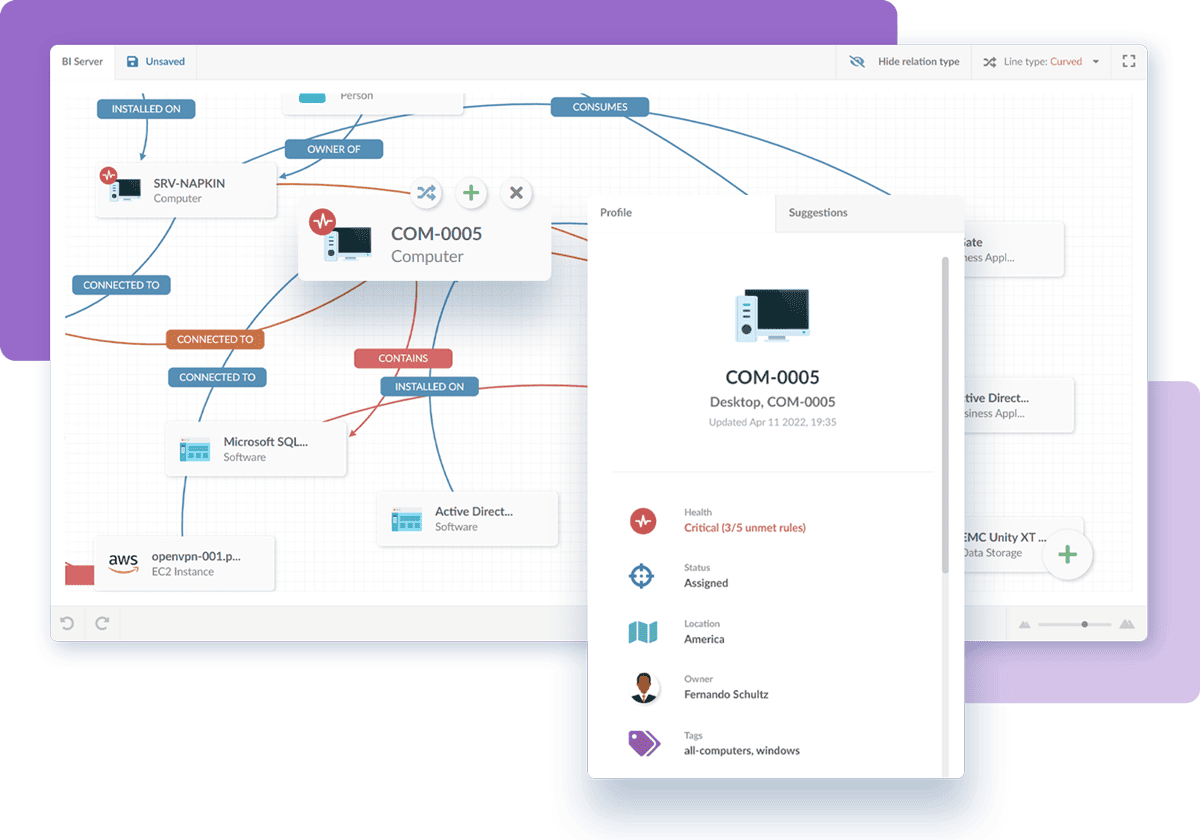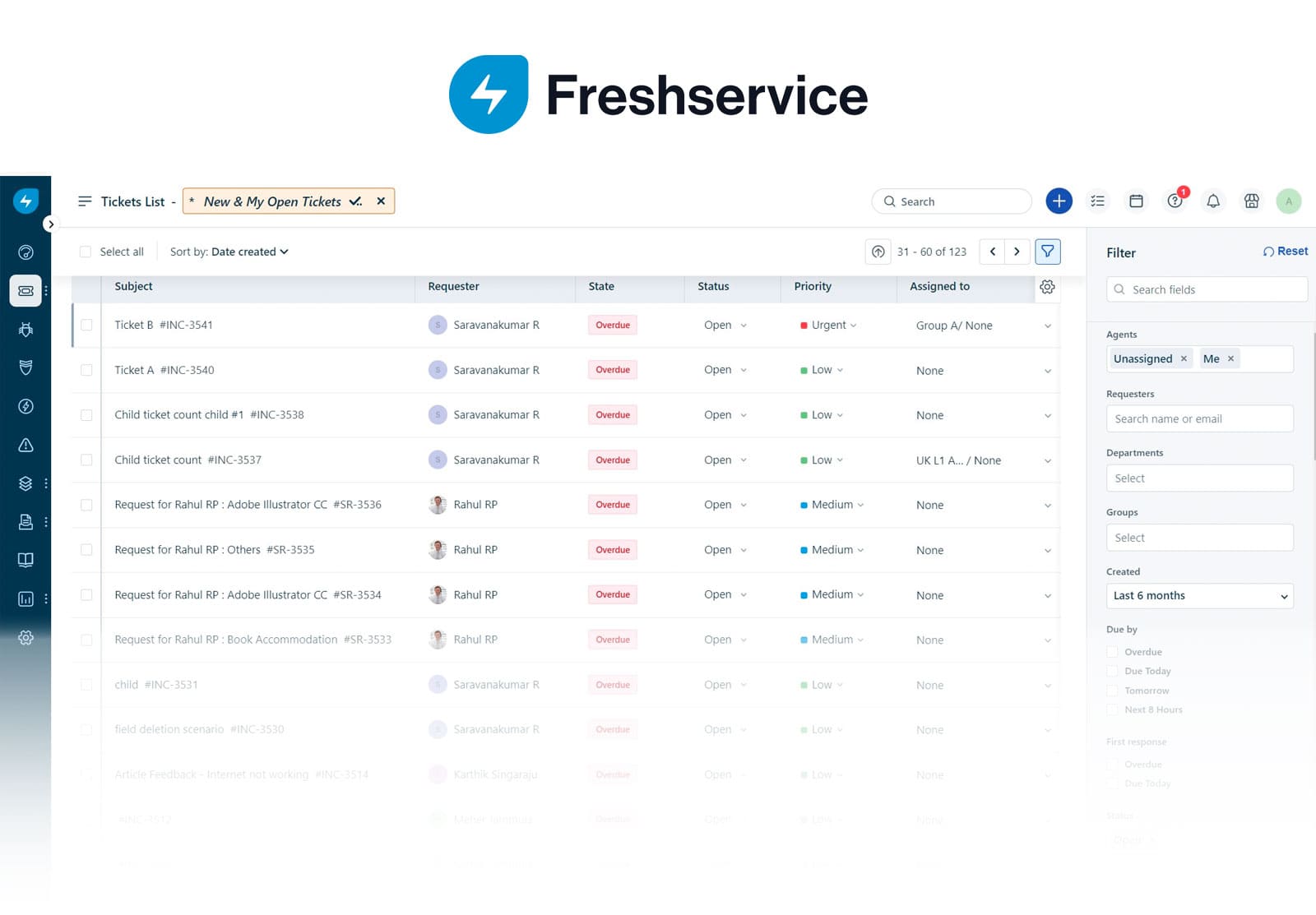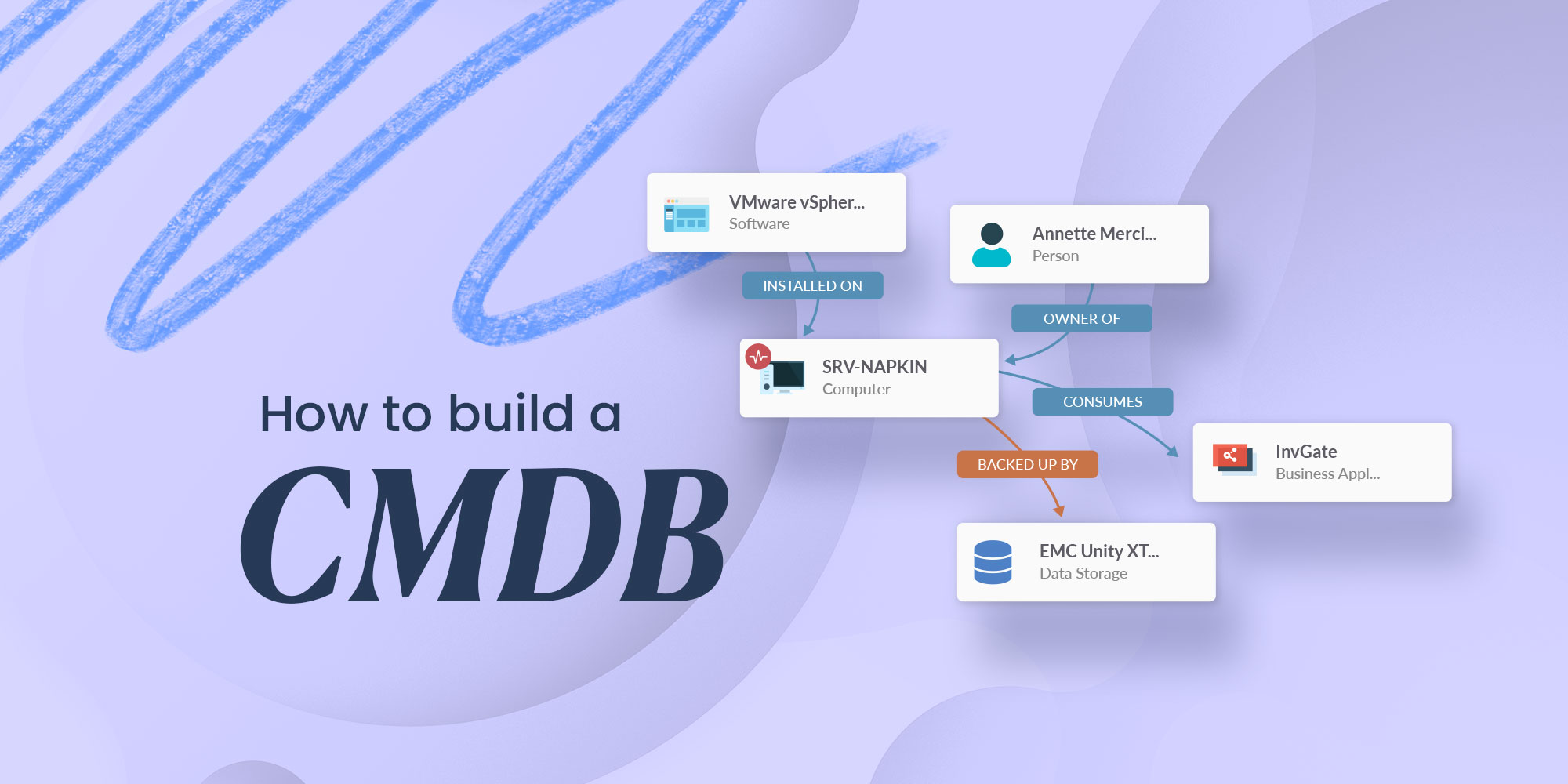It may sound obvious, but having a Configuration Management Database (CMDB) tool is essential for a growing business. Serving as the backbone of IT infrastructure, a CMDB acts as a centralized repository for tracking hardware and software assets, enabling organizations to understand dependencies and maintain seamless operations. Yet, with the market flooded with CMDB tools offering diverse capabilities, finding the right solution for your organization’s unique needs can be challenging.
The good news? You are not alone. The CMDB software market is growing rapidly. Valued at USD 2.56 billion in 2023, it’s projected to reach USD 6.12 billion by 2031, driven by a compound annual growth rate (CAGR) of 12.69%, according to Verified Market Research.
This boom is fueled by increased demand for CMDB solutions that go beyond basic configuration data storage, providing asset discovery, Change Management, and integration capabilities essential for IT Operations Management.
In this guide, we’ll help you navigate the best CMDB tools—whether you're after a dedicated CMDB tool or an IT Asset Management solution with integrated CMDB functionality.
10 best CMDB tools to streamline Configuration Management
We selected 10 CMDB tools to help you evaluate and determine the best fit for your organization. The final choice will depend on several factors, including company objectives, team needs, budget, and each tool’s specific attributes.
Here are our top 10 picks, highlighting whether each is a dedicated Configuration Management Database tool or an IT Asset Management solution with CMDB capabilities.
#1: Device42
Device42 was primarily known for its industry-leading IT infrastructure discovery and mapping capabilities.
Following its acquisition by Freshworks in June 2024, Device42's functionalities have been integrated into Freshworks' suite of IT Service Management and IT Asset Management solutions, enhancing the robustness of these offerings.
Here’s a more concise list of Device42’s CMDB features:
-
Agentless auto-discovery: Automatically identifies and manages Configuration Items (CIs) across your environment, supporting virtual, cloud, and on-premises platforms.
-
Data standardization and enrichment: Uses AI to standardize and enhance CI data, ensuring accuracy and actionable insights for IT operations.
-
Comprehensive visualization tools: Offers tools for data center layout, power management, and IP tracking with drag-and-drop functionality.
-
Integration with ITSM tools: Integrates with JIRA, ServiceNow, Cherwell and Freshworks, providing real-time IT infrastructure mapping for faster recovery and decision-making.
-
RESTful APIs for Custom Integrations: Provides APIs for customized integrations with other CMDBs and automation tools, allowing tailored solutions.
#2: SolarWinds Service Desk CMDB (ITSM tool with CMDB capabilities)

SolarWinds Service Desk CMDB brings valuable CMDB functionality to its IT Service Management platform, providing a centralized repository for managing configurations and assets.
A standout feature is its impact analysis, which helps teams assess the effects of changes on users, systems, and broader Service Management processes. SolarWinds offers flexibility to fit various team sizes and IT environments.
- Comprehensive asset visibility: Centralizes knowledge of critical IT assets, allowing for informed decision-making and efficient incident resolution.
- Dependency mapping: Provides visual representations of asset relationships, aiding in understanding the impact of changes and preventing potential issues.
- Integration with ITSM processes: Seamlessly connects with service desk operations, improving productivity by linking assets to incidents and facilitating quicker troubleshooting.
- Flexible asset entry methods: Supports manual asset entry, network discovery scanning, and integration with systems like SCCM, JAMF, Intune, or vCenter for efficient Asset Management.
#3: Micro Focus Universal CMDB (dedicated CMDB tool)
Micro Focus Universal CMDB is engineered for hybrid IT environments, offering machine learning-powered asset discovery to enhance software license management and track configuration data.
With real-time monitoring and multi-cloud support, it excels in capturing the entire lifecycle of Configuration Items (CIs). Integration with other ITOM tools and tailored pricing makes it suitable for enterprises with extensive IT infrastructure needs.
#4: InvGate Asset Management (ITAM tool with CMDB capabilities)

InvGate Asset Management provides everything most businesses need to get started with a CMDB, offering a comprehensive, 360-degree view of IT assets and infrastructure. Its CMDB functionality maps relationships between applications, systems, and other CIs, making it easy to centralize and track the entire inventory. Having the complete inventory in one place is crucial for effective Asset Management, as it enables better visibility and control over hardware and software assets.
Additionally, InvGate integrates seamlessly with InvGate Service Management, allowing teams to link CIs to tickets and quickly act upon incidents, changes, or service requests. This integration streamlines Service Management processes by connecting asset information directly to support workflows, helping IT teams resolve issues faster and maintain operational efficiency. Ask for our 30-day free trial and see for yourself.
Key features include:
- Visual modeling: Map all IT components and their relationships using a visual CMDB data model, enabling clear identification of trends, patterns, and outliers in an intuitive presentation.
- Flexible data population: Quickly set up your CMDB by merging configuration data from various sources through manual entry, API-driven integrations, and an asset discovery tool, ensuring a detailed map of your IT infrastructure.
- Cloud environment integration: Incorporate assets from cloud services like AWS and Microsoft Azure into your CMDB, supporting day-to-day operations with a centralized visual representation of all resources and services.
- Enhanced IT Service Management (ITSM): Connect the CMDB to InvGate Service Management to facilitate faster incident resolution, quick problem identification, and efficient root cause analysis, thereby improving IT Service Management.
- Change Management support: Utilize real-time data on users, hardware, software, networks, contracts, business sites, and other assets to identify impactful relationships, plan and implement changes, and proactively troubleshoot potential issues before they occur.
#5: vScope (IT Management tool with CMDB capabilities)
vScope offers agentless discovery and documentation of IT environments, providing insights into assets and their dependencies. Its automated reporting and visualization tools enhance transparency and control, making it easier to manage configurations and monitor systems.
vScope's integration capabilities allow for seamless operations across various platforms, supporting compliance reporting and risk management. Pricing details are available upon request from vScope.
Key features of vScope's CMDB include:
- Contextual Asset Management: Easily create and manage various contexts and their relationships to IT assets, offering a richer perspective on Asset Management.
- Optimized ITSM and asset documentation: Centralize and maintain up-to-date databases for services and clients, enabling swift responses to requests, efficient change planning, and enhanced user experiences.
- Automatic data integration: Leverage vScope's leading IT inventory software to automatically populate the CMDB with necessary information about IT assets, ensuring accuracy and reducing manual effort.
- Simplified relationship mapping: Create and update hierarchical structures to clearly visualize interconnections between different IT assets and contexts, aiding in understanding their effects on IT operations.
- Built-in analysis and compliance support: Utilize built-in analyses to identify misconfigurations and understand relationships and dependencies, supporting daily improvements in ITSM and ITAM operations.
#6: Freshservice (ITSM tool with CMDB capabilities)

Freshservice offers a modern, cloud-based CMDB solution within its ITSM platform, integrating Configuration and Asset Management features to support Incident Management and operational efficiency.
Known for its user-friendly interface and automation capabilities, Freshservice provides real-time tracking of assets and dependencies, making it accessible for businesses of all sizes. Pricing starts at $19 per user per month, with scalable plans for growing teams.
Key features include:
- Auto-updating, multi-source CMDB: Integrates real-time connectors with built-in and leading discovery solutions, identity providers, and endpoint management tools, ensuring current and complete visibility of hardware and software assets.
- Integrated source of truth: Serves as a unified repository for asset information, simplifying incident and Change Management processes while effectively reducing risks.
- Comprehensive insights: Provides a 360-degree view to optimize service operations, prevent disruptions, and help meet Service Level Agreements (SLAs). Dependency mapping aids in change deployments and accurate root-cause analyses by assessing upstream and downstream impacts.
#7: BMC Helix CMDB (dedicated CMDB tool)
BMC Helix CMDB delivers a single source of reference for IT assets and services, supporting Service Management processes and enabling organizations to manage configurations effectively.
Its integration with BMC's suite allows for comprehensive IT operations management, including Incident Management, Change Management, and Problem Management. BMC Helix CMDB's automation capabilities and compliance features make it suitable for enterprise customers seeking to enhance operational efficiency. Pricing information is available upon request from BMC.
Key features include:
- Data integration and federation: BMC Helix CMDB combines and federates data from multiple sources, ensuring a comprehensive view of your IT environment.
- Automated population and updates: Utilizing BMC Helix Discovery, the CMDB is automatically populated and updated, maintaining accurate and current configuration data.
- KPI-driven user experience: The platform offers a user experience guided by Key Performance Indicators (KPIs), delivering high-quality data to support business decisions.
- Graphical data visualization: BMC Helix CMDB provides graphical visualization of data, facilitating an understanding of relationships and dependencies within the IT infrastructure.
#8: OpenText Universal Discovery and CMDB (dedicated CMDB tool)
OpenText Universal Discovery and CMDB automatically collect, reconcile, and manage configuration data across on-premises and multi-cloud environments. Its robust discovery and service dependency mapping reduce IT service disruptions and support seamless operations.
The tool's integration capabilities with other IT management tools enable organizations to monitor systems and manage software assets effectively. Pricing details are available upon request from OpenText.
Key features include:
- Complete discovery: Offers both agent-based and agentless discovery methods, providing a thorough inventory of IT assets and configurations, including hardware, software, and endpoints.
- Assisted service modeling: Enables top-down service modeling to understand how infrastructure delivers business-critical applications and services, facilitating effective change and Configuration Management.
- Proactive impact analysis: Allows for the prediction of impacts from planned and unplanned changes, reducing risks and accelerating issue resolution times with detailed configuration change records.
- Vendor-neutral and customizable: Avoids vendor lock-in by working with various systems and offers high customization to meet specific Configuration Management needs.
- SaaS deployment: Provides the latest CMDB features without upgrade hassles, deployable either stand-alone or in conjunction with OpenText SMAX, AMX, or HCMX.
#9: Azure App Configuration (cloud-based solution with CMDB capabilities)
Azure App Configuration manages application settings and feature flags centrally, enhancing security and compliance. Its integration with Azure services facilitates streamlined Configuration Management and supports the entire lifecycle of applications.
Azure App Configuration's automation capabilities and access controls enable organizations to manage configurations efficiently. Pricing is based on usage, with detailed information available on Microsoft's Azure pricing page.
Key features include:
- Centralized Configuration Management: Provides a universal, fully managed configuration store for fast retrieval of configurations across Azure applications, ensuring consistency and reducing configuration errors.
- Feature management: Offers dedicated UI for feature flag management, allowing developers to toggle specific features and respond in real-time to changing demands without redeploying applications.
- Integration with Azure Services: Seamlessly integrates with popular frameworks such as .NET and Java Spring, facilitating streamlined Configuration Management within the Azure ecosystem.
- Security and compliance: Ensures complete data encryption at rest and in transit, with enhanced security through Azure-managed identities, supporting organizational governance and compliance requirements.
#10: ServiceNow CMDB (ITSM tool with CMDB capabilities)

ServiceNow CMDB offers a single system of record for IT, becoming service-aware when paired with ServiceNow Service Mapping. This integration provides full visibility of infrastructure and services, enabling better decision-making and supporting Service Management processes.
ServiceNow CMDB's compliance features and integration capabilities with other IT management tools make it a robust solution for managing configurations and enhancing operational efficiency. Pricing is customized based on organizational needs; for detailed information, contact ServiceNow.
When selecting a CMDB tool, consider your organization's specific requirements, budget, and the features each tool offers to ensure the best fit for your IT environment.
Key features include:
- Comprehensive asset visibility: Acts as a centralized repository for storing data associated with IT assets and Configuration Items (CIs), including servers, network devices, applications, and services, enhancing Asset Management and service delivery.
- Relationship mapping: Clarifies the relationships between hardware, software components, and networks, supporting improved Configuration Management and impact analysis.
- Integration with ITSM processes: Seamlessly connects with service desk operations, improving productivity by linking assets to incidents and facilitating quicker troubleshooting.
- Data standardization and quality: Built on a single data model with a standard taxonomy, predefined semantics, consistent format, data quality standards, and common processes, ensuring data consistency across every database and readiness for every ServiceNow product.
5 must-have CMDB tool features
Choosing the right CMDB tool requires a focus on core features that are essential to effective Configuration Management, asset tracking, and IT Service Management.
1. Automated discovery and dependency mapping
Automated discovery and dependency mapping are foundational to accurately managing configurations and understanding asset dependencies. This feature reduces manual setup by automating data population, ensuring the CMDB reflects the current state of the IT environment.
In dynamic infrastructures, this capability is critical for efficient asset discovery, minimizing service disruptions, and improving Incident Management.
2. Real-time data sync
Real-time data syncing is key to maintaining accurate CMDB data in constantly evolving IT environments. By ensuring that Configuration Items and changes are instantly updated, this feature reduces errors caused by outdated information, helping IT teams stay proactive and enabling organizations to manage configurations with confidence.
Real-time sync is crucial for organizations that rely on timely insights to support service delivery and operational efficiency.
3. Advanced impact analysis
Impact analysis is invaluable for understanding how changes or incidents will affect the entire IT environment. With strong impact analysis, a CMDB can provide visualizations and reports that outline relationships between Configuration Items, allowing IT teams to assess risks proactively.
This feature supports organizations in making informed Change Management decisions, helping prevent service disruptions and maintain compliance with service agreements.
4. Integration with ITSM and ITOM tools
To maximize the value of a CMDB, integration with IT Service Management and IT Operations Management (ITOM) tools is essential. Integration enables seamless workflows in incident, problem, and Change Management, allowing teams to access accurate data across systems.
Popular integrations with tools like ServiceNow, SolarWinds and InvGate Service Management create a single source of truth, centralizing Configuration Management within the broader IT environment.
5. Compliance and Security Management
Compliance and Security Management features protect the CMDB’s data integrity while meeting regulatory standards. Role-based access controls, audit trails, and automated compliance checks help secure configuration data and ensure that the CMDB aligns with organizational governance.
These features not only address security concerns but also enhance data analysis capabilities, allowing organizations to meet legal and internal policies with confidence.

What’s the deal with free and open source CMDB tools?
Free and open source Configuration Management Database software provide organizations with limited budgets a chance to implement a Configuration Management Database solution without high costs. Tools like i-doit and CMDBuild offer core CMDB functionalities and allow for custom configurations, making them a feasible option for managing assets and configurations. These tools also avoid vendor lock-in, providing greater control over configuration data and integration with other management tools.
However, open source CMDB tools often require more technical expertise, as vendor support is typically limited. Without advanced automation or integration features, open source solutions may lack the seamless operations that commercial CMDB software offers. For enterprise customers with complex infrastructure, a commercial CMDB with robust support may be a better investment.
How to implement a CMDB
In episode 90 of Ticket Volume - IT Podcast, Melissa Dunham, IT Support and Services Senior Director at JAMF, shares insights on how to effectively begin implementing a CMDB. Dunham suggests starting with a clear scope and identifying critical CIs and relationships.
"A CMDB isn’t just about documenting assets; it’s about mapping relationships to see interdependencies," she notes, emphasizing that understanding how servers, applications, and databases interact ensures that the CMDB supports broader Service Management goals.
Melissa also highlights the importance of cross-departmental collaboration. Building a CMDB from scratch at JAMF required buy-in across IT, finance, and security teams, creating a foundation where everyone took part in data updates and validation. Consulting experts like Dunham can help teams focus on establishing a CMDB that grows in accuracy and value, supporting both immediate needs and long-term organizational goals.

To sum up
To sum up, a well-implemented CMDB can transform IT management by enhancing visibility, streamlining Configuration Management, and boosting operational efficiency. With CMDB tools growing in popularity, organizations now rely on these platforms not just for data storage but for monitoring dependencies, impact analysis, and Change Management.
As IT environments become more complex, a CMDB’s role as a central repository is essential. Aligning it with business goals, integrating it with IT and Service Management tools, and incorporating automation ensures it remains a valuable asset throughout the lifecycle of configurations and assets. A thoughtfully implemented CMDB empowers IT teams, supports seamless service delivery, and drives long-term growth.















